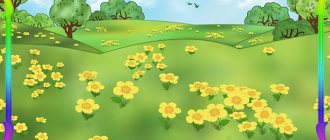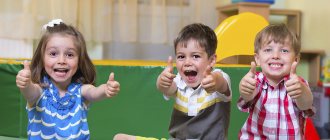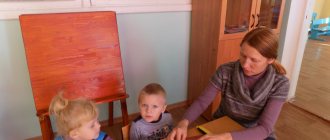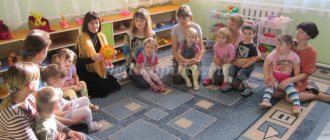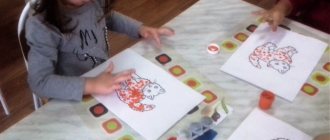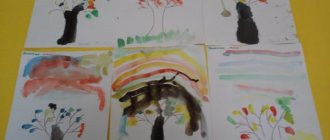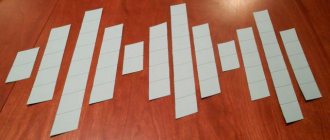Summary of a mathematics lesson in the junior group “Valuity”
Summary of a mathematics lesson in the junior group “Valuity”
Target:
Consolidating the concept of size.
Tasks:
1. Reinforce in children the concepts of one, many.
2. Reinforce the concepts of big and small.
3. Develop the ability to distinguish and group objects by size.
4. Form the ability to generalize.
5. Develop the skill of selecting pairs of objects by size and color.
6. Cultivate emotionally - a positive attitude towards mathematical games.
Methods and techniques:
Methods: gaming, practical, verbal - visual, search and research, surprise moment, verbal, visual
Techniques: questions, instructions, additions, reminders, artistic expression.
Preliminary work: preparing didactic material, working with a subgroup of children, studying methodological literature, studying pictures of counting objects with children, solving riddles.
Equipment, bags, a toy bear, cubes, two strips of different sizes, a magnetic board, pictures with images: forests, huts, three bears of different sizes, three chairs, three cups; handouts for each child (1/2 sheet of white paper with drawn bears of different sizes, three Christmas trees of different sizes).
Progress:
Educator: - Guys, today a guest will come to us. And so that
find out who it is, guess the riddle!
He is brown and clubfooted,
Catches fish with a powerful paw.
And he also loves honey!
Who will call the sweet tooth? (Children's answers)
— A bear came to visit us. Let's say hello to him.
Educator: - Bear did not come to us empty-handed, but brought us
a bag of cubes so that we can help arrange the cubes for him, otherwise the bear has
all the cubes are mixed (pour the cubes onto the mat). And, really,
look how many cubes there are on our carpet. Let's look at them. Which
cubes by size (large and small). What color are the cubes? (blue,
yellow, red, green)
— The bear asks to put the cubes into bags: large cubes in
a large bag, and small ones in a small one.
- Guys, let’s help the bear (the bear thanks the guys for
help).
There are two strips of different colors and sizes on the board.
— Look at these tracks and tell me, are they the same or different? How to find out? What should be done? (compare)
- Look, I’ll put one path next to the other, I’ll align their ends on the left. You see, one end protrudes, which means the red stripe is longer and the green stripe is shorter.
The teacher runs his hand along the paths. Then he calls several children to show the long and short paths. Children also show with their hands the length of the paths.
Bear: - Well done! I enjoyed playing with you. And now it's time for me
leave. Goodbye, see you again! (leaves)
MAGAZINE Preschooler.RF
Lesson notes on FEMP in the second junior groupObjectives: To consolidate knowledge about geometric shapes, answer the question “how many?” ' in words one, many, none.
Continue to develop the ability to form a group of individual objects and isolate one object from it.
Preliminary work: Teach children to pay attention to the shape of objects when performing basic actions with toys and objects in everyday life.
Examination of one and many objects.
Game “Find an object of the same shape in the group.”
Program content.
Educational objectives:
- continue to teach children to conduct a dialogue with the teacher: listen and understand the question asked and answer it clearly
- consolidate and generalize children’s knowledge about the number of objects (one, many, none)
- Strengthen the ability to distinguish and name primary colors: red, blue, yellow, green
Developmental tasks:
- Develop auditory and visual attention, imagination
- Develop speech, observation, mental activity
- Expand and activate children's vocabulary
- Develop logical thinking
Educational tasks:
- Cultivate a desire to work
- Cultivate kindness and compassion
Equipment and materials:
Demonstration: soft toy Bunny. Large and small cubes. Big and small box.
Handout: Large and small cubes according to the number of children. One plate per child. Blue circles in rosettes for each child.
Progress of the lesson:
1. Introduction to the educational game situation
Introduction of the fairy-tale hero Bunny - Stepashka.
- Guys, a guest will come to us today, I’ll tell you a riddle, and you guess who he is?
Lives in a hole - chews carrots
From the fox and from the wolf - he runs away deftly (who is it)
children's answers (bunny)
- That's right, this is a bunny, his name is Stepashka.
2. Main part.
1. Game – task “Put the cubes into boxes” (on the carpet)
Educator:
Guys, our Stepashka is sad. Stepashka, why are you so sad?
-Guys, he says that two boxes of cubes fell apart. Indeed, look how many cubes there are on our carpet. Let's look at them: - Egor, what are the size of the cubes (larger and small). What color are the cubes?
Children name colors (blue, yellow, red, green)
— The Bunny asks to put the cubes into boxes: large cubes into a large box, and small ones into a small box, let us help the Bunny. Look at your cubes. Show the big cube (show) Show the small one (show)
On the teacher’s table there are demonstration cubes: large and small. The teacher is the first to lay out the boxes, accompanying the actions with speech.
-Look, what kind of box is this? (large)
-What is this box? (small)
-Guys, I’ll put the big cube in a large box, and the small one in a small box (the children complete the tasks after the teacher’s explanation, come up one at a time and put the cubes in boxes.)
-So we helped the Bunny: we put the large cubes in a large box, and the small ones in a small box. The bunny is happy, he smiles.
Physical education minute;
One two three four five. The bunnies went out for a walk.
Suddenly the hunter runs out and shoots straight at the bunny.
Beer - pav-oh-oh. My little bunny is running away!
Children, let's invite the Bunny to play with us at the tables.
2. Game task “one and many” (at tables)
Plates are laid out on the table. Each child has his own white plate and a box with handouts (blue circles.)
Educator: Children, you have a white plate on your table. What shape is it? (round) / And there are also boxes in front of you, what’s in them (circles) What color are they? (blue) how many circles? (a lot of). And on plates (none.)
Now you take one mug at a time and place it on your plate. How many circles do you have on your plate (one at a time). How much is left in the box (a lot). Now make sure that there are many circles on the plate, but not a single one in the box. Children complete the task.
How many mugs are in the box? (no one)
And you have (a lot) on your plate. Guys, look, how many circles does Bunny have in his plate? (no one). Let's each of you put one mug on his plate.
-Vika, how many circles will you put in (one)
-Mila, how old are you? (one)
One, one, one, look. How many circles did Bunny collect from you (many)
There was not one, but there were many. Let's give this plate to the Bunny.
“Thank you children! ' - Stepashka tells you.
What a great fellow we are, we helped Bunny assemble big and small cubes and laid out the circles one, many, none! Well done!
Guys, do you know what holiday is coming soon (New Year)
3. Game - round dance: The winter sun rises, he sees a bunny coming.
-Where are you going barefoot through the snow?
It's freezing outside now, you'll freeze your tail and nose off.
-I’m not afraid of frost, I’m in a hurry to get to the Christmas tree
In kindergarten I was invited to dance in an elegant hall!
Children and their teacher dance around the Christmas tree and say to Bunny - Goodbye!
| Next > |
